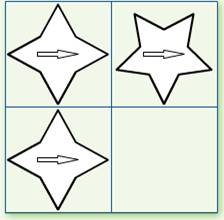
Matrices Questions
Matrices questions are usually presented as a grid of symbols. The grid can be either 2 x 2 or 3 x 3. Working left to right and up and down scan the symbols to observe similarities and differences between them.
You need to look at the elements of the symbols in relation to outlines, shading, line thickness, orientation (i.e. which direction the symbol is ‘pointing’), size, and position in relation to other parts of the main symbol. The number of each of these elements is important too.
In fact, you need to observe all the usual NVR suspects!
Example 1


What observations do we notice about these usual suspects in example 1?
- All 3 matrix clue symbols have a solid external black line, so do all the answer symbols.
- All 3 matrix clue symbols have a white fill, so do all the answer symbols.
- All 3 matrix clue symbols contain identical arrow heads, all pointing to the right.
- The 2 matrix clue symbols on the left have the same outline shape as each other, being 4 pointed stars. The one on the right is a 5 pointed star.
What logical steps can we make when we apply these observations to find the missing Matrix symbol?
- Observation 3 indicates the missing symbol will contain an arrow head pointing to the right so we can discount answers c and d.
- Observation 4 indicates that the missing symbol is a 5 pointed star. We can now discount answer b and e.
- Following these two observations, answer a is the missing Matrix symbol.
Example 2


What observations do we notice about these usual suspects in this example?
- All 8 matrix clue symbols have a solid external black line, so do all the answer symbols.
- All 8 matrix clue symbols have a white fill, so do all the answer symbols.
- All 8 matrix clue symbols contain arrow heads, all pointing to the right top corner.
- Each row contains 3 distinct types of arrows.
- Each column contains 3 distinct types of arrows.
- Each shape is a hexagon.
What logical steps can we make when we apply these observations to the task of finding a missing symbol?
- Observation 4 indicates the missing symbol will contain an arrow head of the type seen in d, so we can discount answers a and c.
- Observation 6 indicates that the missing shape is a hexagon. We can now discount answer d.
- Observation 3 indicates that the arrow should point to the top right. We can now discount answer e.
- Following these two observations, answer b is the missing Matrix symbol.